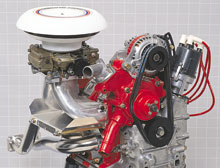Exhaust System Configurations

Racing Beat-modified Holley Intake Kits for 12A & 13B applications.
1979-85 RX-7
There are two popular exhaust system configurations for 1985 and earlier applications that have proven very effective in both street and racing applications: "Short primary" length systems and "Long primary" length systems. Both are "collected" systems that exit through either a single muffler or a single collector/megaphone.
In many instances the selection of either a long primary length system or a short primary length system is dictated by the particular application: i.e. a stock RX-7 chassis or a specialized engine installation in a vehicle other than an RX-7.
As a more economical alternative to headers - simply replace the catalytic converter(s) with a heavy-wall steel replacement pipe. The power increase is significant - typically about 2/3 of the horsepower gain that a header will offer. While the noise level is significantly higher than stock, as it is intended for race track use, it is possible to change from the stock muffler to the Racing Beat Power Pulse™ muffler for an additional power increase combined with a slightly lower, more mellow exhaust note. During testing over the years, we have not discovered any significant performance gains by increasing the tubing diameter of the stock connecting pipe section and we therefore never developed a replacement unit. We suggest you replace this unit only if your stock component has failed. (Mazda offered many different versions of this connecting pipe for the various RX-7 models, further adding to the complexity of offering an aftermarket replacement unit.)
Shown below are typical examples of both the Short and Long primary exhaust systems that are suitable for use on the 1979-85 RX-7. These components are "bolt-on" components and are offered as complete sets, or as individual components. (The connecting pipe section is available at Mazda.) If you are designing an exhaust system for another rotary application, use these samples as a guide.


1986-92 RX-7
The 1986-92 RX-7 was equipped with several catalytic converters that were mounted between the exhaust manifold and Y-pipe section. The Y-pipe section fed directly into a pair of mufflers. Removing the restrict catalytic converters for racing applications has proven to offer significant performance increases.
The non-turbo 13B 6-Port engine, in stock form with the factory fuel injection, produces similar power gains with either our Header/Presilencer Combination or our Catalytic Replacement Pipe/Presilencer combination. Both of these systems replace the exhaust manifold and ALL catalytic converters, and bolt-up directly to the Y-pipe section.
If you have no intentions of upgrading the intake system, we recommend the Catalytic Converter Replacement Pipe/Presilencer combination since it offers a slightly quieter exhaust note, is easier to install and is less costly. If you are intending to upgrade the intake or fuel injection system, the Header/Presilencer combination offers the greatest performance potential. For complete information and photos of all of the various exhaust systems and components that we offer for the 1986-92 RX-7, 1986-92 RX-7 Exhaust Information.
For the TURBO II RX-7, impressive horsepower gains can be realized by replacing the entire stock exhaust system with a larger diameter system. The Racing Beat REV TII Complete Exhaust System will deliver up to 60 additional horsepower on an otherwise stock TURBO II RX-7. The use of this system requires the use of a Fuel Cut Controller to prevent pre-programmed rear rotor fuel cutoff due to higher boost pressures.
1993-95 RX-7
Like most turbo applications, the FD3S RX-7 benefits from a larger diameter exhaust system. We have found that many 3" OD aftermarket systems produce similar performance gains and appearance and sound contribute to the major differences with regards to these systems. The Racing Beat system was developed to more closely resemble the factory appearance, and features either a Dual Outlet or Single Outlet tip configuration.
Custom Exhaust Systems
If you plan on developing your own custom exhaust, use the following information to fabricate your system.
The exhaust system primary tube lengths shown in the following table, all assuming a collector and megaphone assembly, have proven suitable for racing. All lengths are measured down the center of the tube from the engine flange to the "crotch" of the collector. The angle of convergence of the collector should be 30° to 40°.
| Non-ported, Street-port, Bridge-port w/stock or Weber carburetor |
Bridge-port w/600CFM or 650CFM Holley |
Peripheral Port |
|---|---|---|
| Short system 22 to 25 inches |
Short system 15 to 18 inches |
Short system 10 to 18 inches |
| Long system 120 to 125 inches Both short and long systems require primary tube inside diameter of 1.7 to 1.8 inches. |
Long system 113 to 118 inches |
Long system 89 to 94 inches Inside tube diameter required is 1.9 to 2.0 inches. |
If a megaphone is attached to the rear of the collector, the smallest area of the collector, where it joins the megaphone, should be 3 to 4 square inches: equal to a 28-inch hole diameter. A peripheral port application requires 4 to 5 square inches: equal to a 2.375-inch hole diameter. The megaphone should be between 10 to 14 inches in length, with an exit diameter of 4-inches.
Additionally, there is another exhaust system configuration which has proven very effective in street applications only and is found on all stock 1986-92 13B 6-Port RX-7s: two separate exhaust primaries that are collected near the middle of the chassis and then split apart to exit through two separate mufflers (assuming your chassis has room for two mufflers). This arrangement mixes the exhaust pulses and reduces exhaust noise.
Copyright 2007-2024 Racing Beat, Inc ©




